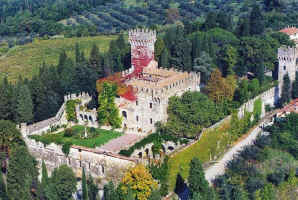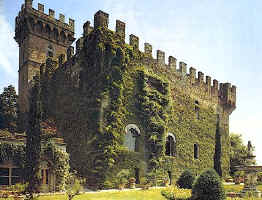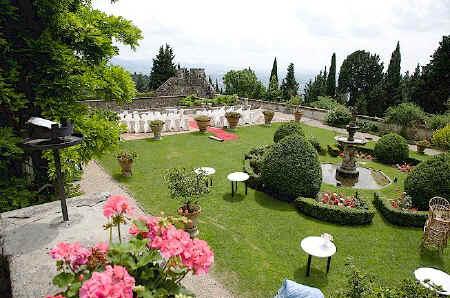During the 19 C a number of very rich English expatriates settled permanently in Florence and its environs where they purchased villas and castles, often in ruinous state, and restored them to their former splendour, often filling them with remarkable collections of art. Perhaps equally importantly, they restored or created magnificent gardens, often of great originality, in the Tuscan style. One such expatriate was John Temple Leader, (1810-1903), former MP for Westminster, connoisseur and author, who, in 1885, purchased the mediaeval Castle of Vincigliata and spent twelve years redesigning it in Victorian Gothic revival style. A number of original crests can still be seen in the courtyard, and a fine fresco cycle dating back to the 14 C also survived the renovation work. The 19 C scheme was not limited to the restoration of the building but also included its surroundings. Over the course of 50 years, 600 acres of quarry-scarred hills were planted with trees and dense undergrowth suited to the rocky terrain, creating the magnificent forest that can be seen today. Cypresses were also introduced here and there among the pines and holm-oaks, creating an unusual mix of conifers and deciduous trees. Leader was assisted in his landscaping scheme by the architect Giuseppe Fancelli and hydraulics expert Alessandro Papini.
In the second half of the 19 C, Temple Leader purchased the ancient "Cava delle Colonne", a quarry the name of which alludes to the fact that it is the origina of the stone used to make the columns of the Princes' Chapel in the church of San Lorenzo. This natural basin, which was transformed into a reservoir using water from the Mensola river, is the most conspicuous feature of the large romantic park. On one side of this lake, the shoreline takes the form of craggy rocks assembled to create artificial caves, on the other an embankment was built. The waters are overhung by the surrounding trees and the pond itseld is well provided with water lilies, papyrus, reeds and rushes. All the buildings in the park were constructed before 1883, with the exception of the Gothic-style tower (1885-1886), the visual focal point of this charmingly atmospheric bathing area. The tower, topped by a protruding walkway with Guelph-style crenellations, is very similar to the one on the castle's watch tower. The ladies' changing cabin, a Swiss chalet-style built over the water and supported by piles, has been lost during the course of the years. The Maria Luisa Bridge connects the two sides of the river, beyond which stands the Kaffeehause with its elegant loggia. This building was originally used as a storeroom for equipment used in the nearby quarries. The garden surrounding the waters of the Laghetto delle Colonne is criss-crossed by paths that wind their way through the dense vegetation, encountering on their way various typical romantic garden features: ornamental bridges, walls, statues of mythological monsters and a nymphaeum-grotto. The time when Queen Victoria came to Vincigliata Castle in 1893 as a guest of Temple Leader is memorialised in a stone tablet. Vincigliata Castle was used by the Germans as a prison for English officers during the War. Currently Vincigliata Castle may be rented for wedding celebrations and similar events. Castello di Vincigliata gardens
|


